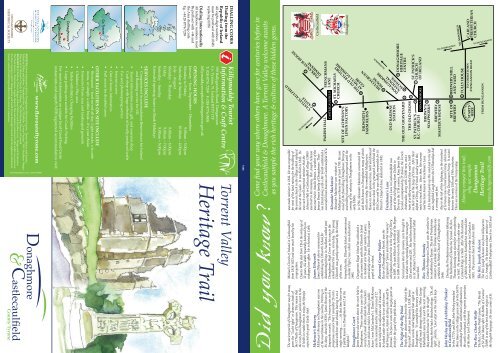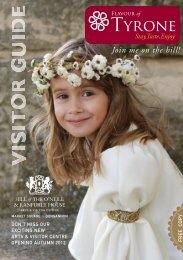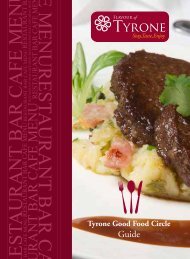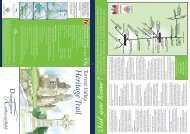Castlecaulfield Heritage
Torrent Valley Heritage Trail - Discover Northern Ireland
Torrent Valley Heritage Trail - Discover Northern Ireland
- No tags were found...
Create successful ePaper yourself
Turn your PDF publications into a flip-book with our unique Google optimized e-Paper software.
DONAGHMORE<br />
HISTORICAL SOCIETY<br />
SOURCES: From information held at Donaghmore Historical Society, ’Tyrone History and Society’<br />
Edited by Dillon and Jeffries. ‘Domhnach Mor’, by O’Doibhlin, ‘Tyrone Precinct’ W.R. Hutchison. Burges<br />
History of St. Michael’s Church. R.J. Mclean, ‘The Old Meeting House’ at Carland.<br />
Research: PJ Rafferty, Patricia Bogue, Robert McLean and Jonathan Gray. Design and Production:<br />
The Pixel Factory. Illustrations: Angela Hackett. The information contained in this leaflet was correct at<br />
the time of going to print. Dungannon and South Tyrone Borough Council and Donaghmore Historical<br />
Society cannot be held responsible for the errors or omissions.<br />
www.flavouroftyrone.com<br />
www.thepixelfactory.co.uk - 028 8772 6963<br />
Donaghmore<br />
& <strong>Castlecaulfield</strong><br />
County Tyrone<br />
For more information on unique local Good Food Circle<br />
restaurants and superb NITB registered accommodation visit:<br />
• Large parking area suitable for Coach Parking<br />
• Toilets with Baby Changing Facilities<br />
• Children’s Play area<br />
• Extensive Picnic area and landscaped grounds<br />
OTHER FACILITIES ON SITE INCLUDE<br />
• Restaurant – food served all day. Light snacks, a la carte<br />
menu, or simply a coffee break – it’s your choice<br />
• Full access for disabled users<br />
• Out-of-hours information<br />
• Internet access<br />
• Fax and photocopying service<br />
• Tourist information centre, gift, and souvenir shop<br />
Craft shop with large selection of locally produced crafts<br />
SERVICES INCLUDE<br />
• Computerised Accommodation Reservations for Ireland<br />
and Booking service for UK<br />
Dialling Internationally<br />
All telephone numbers must<br />
Be prefixed with +44 and<br />
the Area dialling code<br />
Eg. +44 28 8776 7259<br />
OPENING HOURS<br />
January – June, September – December<br />
Monday to Friday 9.00am – 5.00pm<br />
Saturday & Sunday 10.00am – 4.00pm<br />
July – August<br />
Monday – Thursday 9.00am – 6.00pm<br />
Friday 9.00am – 7.00pm<br />
Saturday – Sunday 9.00am – 5.00pm<br />
Extended opening hours on Bank Holidays<br />
DIALLING CODES<br />
Dialling from the<br />
Republic of Ireland<br />
All eight-digit numbers<br />
must be prefixed with (048)<br />
replacing (028)<br />
Killymaddy Tourist<br />
Information & Craft Centre<br />
190 Ballygawley Road, Dungannon<br />
Co. Tyrone, N. Ireland BT70 1TF<br />
T: 028 8776 7259 F: 028 8776 0908<br />
killymaddy.reception@dungannon.gov.uk<br />
Torrent Valley<br />
<strong>Heritage</strong> Trail<br />
S108<br />
Come find your way where others have gone for centuries before in<br />
<strong>Castlecaulfield</strong> & Donaghmore. A Torrent Valley welcome awaits<br />
as you sample the rich heritage & culture of these hidden gems.<br />
Did you know ?<br />
Parkanaur House<br />
Demesne<br />
15<br />
<strong>Castlecaulfield</strong><br />
Castle<br />
was made minister in 1841. He was responsible<br />
for most of the fund raising for the building of<br />
the present church in the village which replaced<br />
the one at the Castle. It was built in 1843. He<br />
was such a well respected minister that the<br />
Acheson Hall in <strong>Castlecaulfield</strong> village (1908)<br />
was built in his memory. Rev. Joseph Acheson<br />
was married to Amelia Brown, a member of the<br />
famous Brown family of Donaghmore. Their<br />
son David along with a Mr Smith established a<br />
successful linen business at <strong>Castlecaulfield</strong> 1874.<br />
Michael’s Church of Ireland in <strong>Castlecaulfield</strong><br />
from 1818-1823 and was much loved by his<br />
congregation.<br />
Charles Wolfe died from TB at the early age of<br />
32 years, his death reputedly hastened by an<br />
unhappy love affair. He is buried at Cobh.<br />
The ancient parish of Donaghmore was for many<br />
years the “Lucht tighe” or demesne lands of<br />
the O’Neills of Dungannon. This means that<br />
the rents from Donaghmore parish went to the<br />
O Neills to enable them to enjoy the lifestyle<br />
expected of a great Gaelic chief.<br />
14<br />
To Dungannon<br />
<strong>Castlecaulfield</strong><br />
Frenchmans<br />
lane<br />
Parish Hall<br />
<strong>Castlecaulfield</strong><br />
The Old Rectory<br />
at Mullaghmore<br />
Glebe<br />
St. Michaels<br />
Church<br />
13<br />
Donaghmore<br />
site of Acheson’s<br />
Linen Factory<br />
Alexander Mackenzie<br />
Alexander Mackenzie was resident at<br />
Mullygruen House from at least 1790. He was<br />
owner of the flourishing Donaghmore Brewery<br />
and milling business which prospered until the<br />
coming of the railway to Donaghmore in the<br />
early 1860s.<br />
In 1796 Alexander Mackenzie constructed 88<br />
well built houses in Donaghmore many of which<br />
still exist today. He remodelled Mullygruen<br />
House on more spacious lines, built and financed<br />
an infant school in the graveyard just behind the<br />
Old Cross and he was chiefly responsible for St.<br />
Patrick’s Chapel of Ease, dedicated in 1843.<br />
James Dilworth<br />
James Dilworth who is renowned for<br />
establishing the Dilworth School for<br />
disadvantaged boys in Auckland, walked past<br />
Donaghmore High Cross on his way to the<br />
school behind the cross, every day. The young<br />
Dilworth was greatly impressed by the beauty<br />
of the cross.<br />
Inspired by this, Dilworth School commissioned<br />
a similar High Cross, which was dedicated in<br />
1995.<br />
Dungannon Royal School has cultivated a<br />
close connection with the Dilworth School<br />
in Auckland over the past number of years,<br />
particularly since James Dilworth was a past<br />
pupil of the school.<br />
McKenzie’s Brewery<br />
McKenzie’s Brewery in Donaghmore was one<br />
of the most famous in the country. Writing in<br />
his diary about the 1830’s, James Brown of the<br />
Soapworks records. “The brewery was such a<br />
prosperous concern that I remember 28 carts<br />
loaded with beer and whiskey leaving it on a<br />
single morning……….At that time there were<br />
5 public houses in Donaghmore and 2 at the<br />
Backford.”<br />
12<br />
Mullygruen<br />
House<br />
Dilworth<br />
Farm Ruins<br />
To Pomeroy<br />
Donaghmore<br />
National<br />
School<br />
11<br />
Old Railway<br />
Station<br />
Donaghmore Court<br />
James Brown also writes about the court held in<br />
Donaghmore. “There was then a court for the<br />
recovery of small debts called the Seneschal’s<br />
Court which was held in Donnelly’s public<br />
house ( now McCausland’s ). Daniel McKenzie<br />
was the seneschal and he called a jury of 12<br />
men to help him to adjudicate and it was said<br />
he looked under the table to see which men<br />
had brogues on, before deciding who should be<br />
foreman. The fees or costs were largely spent on<br />
drink for the good of the public house.<br />
Donaghmore<br />
<strong>Heritage</strong><br />
Centre<br />
9<br />
8<br />
10<br />
The Old Graveyard<br />
The Old Cross<br />
St. Patrick’s<br />
Church<br />
of Ireland<br />
6<br />
7<br />
5<br />
Frenchman’s Lane<br />
Frenchman’s Lane in <strong>Castlecaulfield</strong> was<br />
part of the old highway from Dublin to<br />
Derry in the 17th century. King James the<br />
Second, accompanied by D’Avaux, the French<br />
Ambassador, along with 12,000 men, and a<br />
train of artillery travelled this road in 1689<br />
on their way to the Siege of Derry. After their<br />
defeat at Derry, the French cavalry used this<br />
route to travel home. Since then, this narrow<br />
road has been known as Frenchman’s Lane.<br />
A few hundred yards up this road and to the left<br />
was Aughlish Lough where the O’Donnellys had<br />
a crannog and fort.<br />
Also to the left of this highway, in the townland<br />
of Terrenew was a Franciscan Friary, which was<br />
an outpost of the Dungannon Friary. It existed<br />
between the early 18th and 19th centuries.<br />
There are no traces of the Friary today.<br />
Reverend George Walker<br />
Rector of Donaghmore Parish, was the<br />
clergyman of “pious and immortal memory”<br />
who played a pivotal role in the Siege of Derry<br />
in 1689. He was killed at the Battle of the Boyne<br />
in 1690 and interred on the battlefield.<br />
Several years later his remains were brought to<br />
his widow who reputedly paid the messenger<br />
£10 and some said £20. She had them deposited<br />
in St. Michael’s Church and a memorial tablet<br />
inscribed.<br />
Donaghmore<br />
St. Patrick’s<br />
R.C. Church<br />
4<br />
Brown’s<br />
Soapworks<br />
3<br />
Brewery<br />
Master’s House<br />
The Night of the Big Wind<br />
People often dated events from the ‘night of the<br />
big wind’, which was January 5, 1839. James<br />
Brown records what happened that night in<br />
Donaghmore. “It unroofed the brewery coolers<br />
and did much damage elsewhere. When George<br />
Mulholland came to his work the next morning,<br />
they asked him how he ‘put in the night’,<br />
knowing that he had a thatched cottage. ‘Oh, all<br />
right’, said he, ‘I just slept on the roof to keep<br />
it on’.”<br />
To Cookstown<br />
To Newmills<br />
Brewery Mill<br />
and Yard<br />
2<br />
2<br />
Site of<br />
Brewery<br />
Tully House<br />
1<br />
To Cookstown<br />
/Dungannon Road<br />
Rev. Thomas Kennedy<br />
Carland Presbyterian Church was the earliest to<br />
be established in Tyrone. The first Presbyterian<br />
minister of Carland, Rev.Thomas Kennedy was<br />
settled in the Parish Church of Donaghmore in<br />
1646.<br />
During the Presbyterian persecutions following<br />
the Restoration of Charles the Second, the Rev.<br />
Thomas Kennedy was ejected for non conformity<br />
in 1662. He operated from a log-cabin near<br />
Carland Bridge in 1668. After the Revolution<br />
of 1688 he retired to Scotland but returned here<br />
and erected a house of worship in Carland in<br />
1693. The present church dates from 1859.<br />
John Wesley and Archbishop Plunket<br />
in Castlecaulfeild<br />
In the 1770’s and 80’s John Wesley preached<br />
three times on the village green and in the 1670’s<br />
Archbishop Plunket celebrated Confirmation in<br />
the castle courtyard, with the express permission<br />
of the then Lord Charlemont.<br />
Carland<br />
Presbyterian<br />
Church<br />
HERITAGE TRAIL<br />
STARTS<br />
HERE<br />
To Dungannon<br />
From Dungannon<br />
Having enjoyed this trail,<br />
why not sample<br />
Dungannon<br />
<strong>Heritage</strong> Trail<br />
www.dungannonlife.com<br />
The Rev. Joseph Acheson<br />
The Rev. Joseph Acheson was from Killycarron<br />
Co. Armagh. He became assistant minister of<br />
<strong>Castlecaulfield</strong> Presbyterian Church in 1833 and<br />
The Rev. Charles Wolfe<br />
The Rev. Charles Wolfe’s poem, “The Burial<br />
of Sir John Moore after the Battle of Corunna”<br />
(1809) is one of the best known elegies in<br />
the English language. He was curate of St.
strong<br />
2. Donaghmore Brewery<br />
The brewery at Donaghmore was founded by Alexander<br />
Mackenzie in 1797. Donaghmore Ale was a well known<br />
and respected product. Some whiskey was also produced.<br />
Across the road from the brewery was the cornmill where<br />
oats and barley were milled for brewing and distilling. The<br />
brewery flourished until the coming of the railway in 1861 when<br />
local markets were flooded by the larger breweries in Belfast and<br />
Dublin.<br />
4.<br />
Brown ’s Soapwork’s<br />
Brown’s Soap and Candle Works were set up by David<br />
Brown in 1820. The firm gave much needed employment<br />
for 140 years. Colleen soap was one of their best known<br />
products. In 1895 Browns bought McClintons of Belfast<br />
and they retained the name.<br />
The firm created an entire village called Ballymaclinton<br />
Village at the White City Exhibition in London in 1908.<br />
From 1880 until its closure in 1953 it was the largest soap<br />
factory in Ireland.<br />
Browns also manufactured plant sprays and fertilizers.<br />
6.<br />
The Old Cross<br />
1. Tully House<br />
7. St Patricks<br />
Church of Ireland<br />
Tully House is one of oldest houses in Donaghmore.<br />
It was built in 1714 by Thomas Ker M.D. who had<br />
originally come from Scotland around 1688. His<br />
brother Andrew had settled in Co. Monaghan.<br />
As well as being a doctor Thomas Ker also<br />
leased several townlands in the Parish from<br />
Lord Charlemont. His daughter Anne married<br />
Henry Verner of Armagh whose son Thomas<br />
became a major landowner in Ireland. A number<br />
of Verner descendants had distinguished military and<br />
parliamentary careers and the family also had<br />
links to the Orange Order.<br />
3. The Brewery<br />
Master ’s House<br />
Used as the Glebe House for St. Patrick’s Upper until<br />
the early 1930s when Donaghmore Upper was grouped<br />
with Pomeroy. The minister was then transferred<br />
to Thornhill Glebe.<br />
Formerly this was the Brewery Master’s house built in<br />
1797. The Brewery master controlled the dispatch of all<br />
beer and spirits from the brewery through a gate on the<br />
upper (west) side of the building.<br />
Note the date-stone set into the low wall on the Main St.<br />
Brewery Court estate was built on the site of the old brewery.<br />
St Patricks R.C. Church<br />
In the 1731 Report on the State of Popery in Donaghmore two mass<br />
houses were recorded. There was already a chapel here in 1806 but<br />
after Catholic Emancipation 1829 things began to move again in<br />
the parish. Fr. Neil McGuckian became parish priest in 1837 and<br />
he began to build schools and churches in the parish. The existing<br />
church was demolished in 1845 and this new larger and higher<br />
one built on the site.<br />
The Old Cross dates back to the 9th Century and is a relic of the<br />
monastic settlement in Donaghmore which lasted from the<br />
6th - 12th Century. The cross is a composite of two sandstone<br />
crosses that were found along the banks of the River Torrent in<br />
the 18th Century. It was erected in its present position by the Rev.<br />
Richard Vincent in 1776. Carvings on the east face depict scenes from<br />
the New Testament and on the west face are scenes from<br />
the Old Testament.<br />
5.<br />
8. Donaghmore Old<br />
National School<br />
(The Pink School)<br />
The old school in the graveyard was<br />
knocked down in 1858 and was replaced<br />
by this new school which was called<br />
Donaghmore National School but was<br />
more commonly known as the Pink School.<br />
It was a Day School and an Evening School.<br />
Bernard Brennan and his wife taught in the<br />
school for many years and in 1882 Bernard was<br />
awarded the Carlisle Blake Premium, the highest<br />
educational award. The school closed in the 1950s.<br />
10. Donaghmore Old Graveyard<br />
This is one of the oldest graveyards in Ireland.<br />
St Patrick established a church in Donaghmore in the 5th<br />
century and from it developed a monastic settlement.<br />
It is likely that the old graveyard dates from<br />
then. There is evidence that an early abbey<br />
existed within the graveyard. In 1622 a<br />
new Protestant church was built inside the<br />
graveyard but this was severely damaged<br />
during the 1641 Rebellion.<br />
In the early 1830s a schoolhouse was built<br />
just behind the old cross. People of all<br />
denominations were buried here.- Including<br />
Rev. Thomas Kennedy of Carland Presbyterian<br />
Church. There are over 420 headstones. A replica<br />
of the old cross is situated in the graveyard (2001).<br />
Remains of a 7th Century Horizontal Mill exist there.<br />
The original Parish Church of Donaghmore was replaced<br />
in 1687 by St. Michael’s Church at <strong>Castlecaulfield</strong>. This<br />
church was built as a Chapel of Ease mainly through the<br />
influence of Alexander Mackenzie who owned the local<br />
brewery. Donaghmore Upper was created a Perpetual<br />
Curacy on 1st April 1843 and the church was built and<br />
consecrated in September 1843.<br />
It was enlarged in 1867 when the semi-circular apse and square<br />
tower were added.<br />
9. Donaghmore <strong>Heritage</strong> Centre<br />
St. Patrick’s National School Donaghmore<br />
This school was built by Canon McCartan in 1883.<br />
It had one large room with a partition. Boys and<br />
girls were educated separately until 1917 when<br />
the two schools amalgamated. The school closed<br />
in 1958 and lay unused until a group of local<br />
people got together in the 1980s and formed a<br />
historical society. The building was refurbished<br />
and opened as a heritage centre in 1988.<br />
Many local historical records, artefacts, maps and<br />
local valuations are housed here. Public lectures are<br />
held monthly.<br />
11.<br />
Mullygruen House<br />
The George Walker House / St. Joseph’s Convent / St.<br />
Joseph’s Grammar School<br />
The Vicars of Donaghmore used this site from the earliest<br />
times for their residences. The Rev. George Walker<br />
built a house here in 1683 which was destroyed during<br />
the Jacobite Wars 1689-1703. His son John rebuilt it in<br />
1707. After the Walker family left Donaghmore, the<br />
Blackhalls were the next owners and after them came<br />
Alexander Mackenzie, owner of a successful brewery<br />
in Donaghmore. Then came the Lyle family and in the<br />
1920s the Daughters of the Cross of Liege took possession<br />
of it. They opened a secondary school for girls which<br />
flourishes as a co-educational school now.<br />
12. The Old Rectory at Mullaghmore Glebe<br />
(On <strong>Castlecaulfield</strong> Rd. opposite. Dilworth farm entrance)<br />
The Glebe house was originally at Mullygruen but in 1735 Lord<br />
Charlemont exchanged the Glebe lands and house for the<br />
townlands of Killyharry and Mullaghmore because he<br />
wanted a Glebe house more convenient to St. Michael’s<br />
church. In 1737 the Rev. Richard Vincent built part of<br />
this Glebe house in Mullaghmore. In 1810 another<br />
addition was added. This old rectory and Glebe<br />
lands were sold in 1957 and a new rectory built in<br />
<strong>Castlecaulfield</strong> in 1958.<br />
The Dilworth Farm<br />
Directly opposite the Old Rectory and a short distance from<br />
the road, lie the ruins of the Mullaghcreevy home of James<br />
Dilworth, the founder and benefactor of the Dilworth School in Auckland,<br />
New Zealand.<br />
14. <strong>Castlecaulfield</strong> Castle<br />
St Michaels Church<br />
The original Parish Church of Donaghmore, situated in<br />
Donaghmore Old Graveyard and had been severely<br />
damaged in the 1641 Rebellion. In 1673 Lord<br />
Charlemont decided to have a new church built on a<br />
site adjacent to his house at <strong>Castlecaulfield</strong>. The new<br />
church was consecrated in 1687. It consisted of a nave<br />
and a tower which was surrounded by a steeple and it<br />
had a gallery. The original steeple had been cracked by<br />
vibrations from the bell and had to be taken down. The<br />
Transepts and Chancel were added about 1861. Two figures<br />
built into the north wall of the tower are said to have come<br />
from Donaghmore Abbey and a sundial on the south side of the<br />
tower is dated 1685.<br />
The Rev. George Walker and his wife Isabella are buried inside the church.<br />
In 1609 Sir Toby Caulfield, an English soldier who had fought for Queen<br />
Elizabeth the First in Spain and the Lowlands and against Hugh<br />
O’Neill in Ireland, was rewarded by King James the First with 1000<br />
acres at Ballydonnelly. He later received a knighthood and became<br />
Lord Charlemont. Here he built a village for his men which he called<br />
<strong>Castlecaulfield</strong> and in 1614 he built this castle for himself in the<br />
English style. It is generally believed an O’Donnelly fort originally<br />
stood here.<br />
The castle was built from limestone and probably had a slated roof. It<br />
had cellars, a small court, and a medieval style gate lodge for defensive<br />
purposes. The site was not a particularly defensive one.<br />
In the Rebellion of 1641 the castle was attacked by the O’Donnellys and<br />
burned and it has been a ruin ever since.<br />
The Parish Hall<br />
The Parish Hall is built on the site of the Old Co-operative creamery 1898-1924. In<br />
1927 Mrs Burges bought the creamery premises and presented them to St. Michael’s church for use as a<br />
parish hall. It was re-named Parkanaur Hall. Over 120,000 American servicemen arrived in Northern<br />
Ireland in 1942 and a number of them were billeted in the Parkanaur Hall and in local farm hay sheds.<br />
Their meals came from the nearby cook-house.<br />
13.<br />
15. Parkanaur House and Demesne<br />
Parkanaur House and Demense belonged to the Burges family.<br />
In 1771 Ynyr Burges of Eastham in Essex bought five<br />
townlands in this area as a dowry for his daughter, but<br />
when he and his son in law came to see the land they<br />
were so disappointed in it that they leased it to his<br />
cousin John Burges of Armagh who mortgaged it and<br />
it passed down his line to John Burges and then to<br />
Ynyr Burges the diarist.<br />
The first house built on the property in 1800 was<br />
a small lodge which was extended in 1820. As the<br />
19th century progressed both house and gardens<br />
were greatly developed. Gate lodges were added and<br />
thousands of trees planted.<br />
Many tenants were forced from their tenancies<br />
to make way for the plantations.







